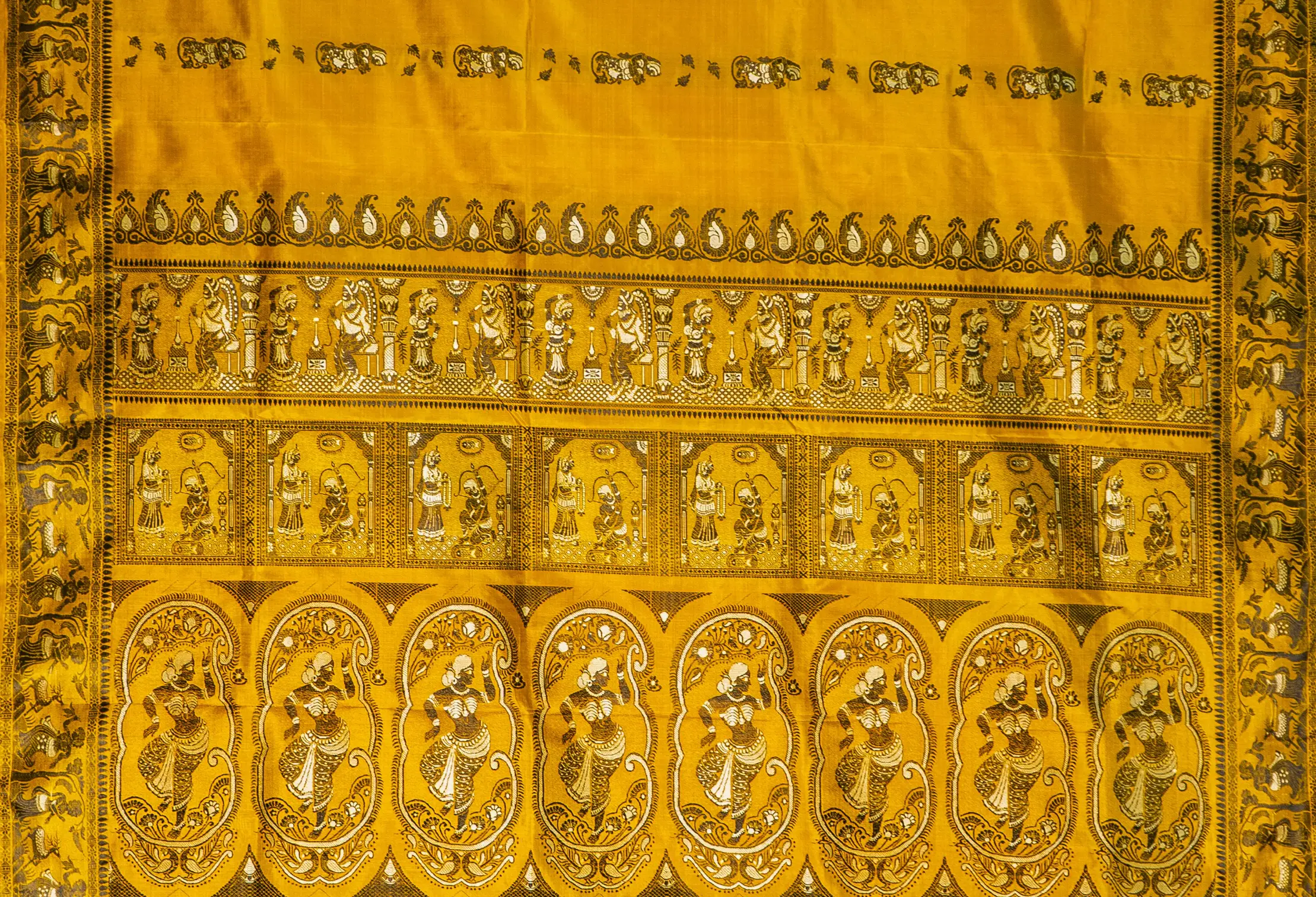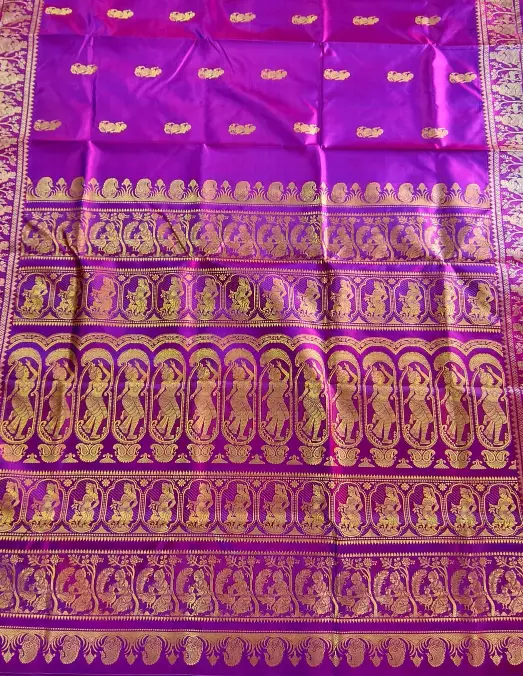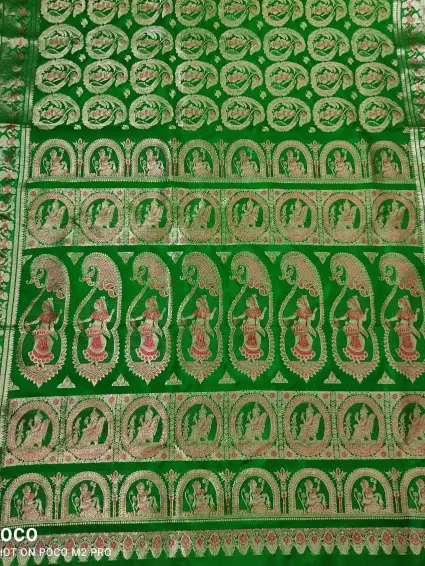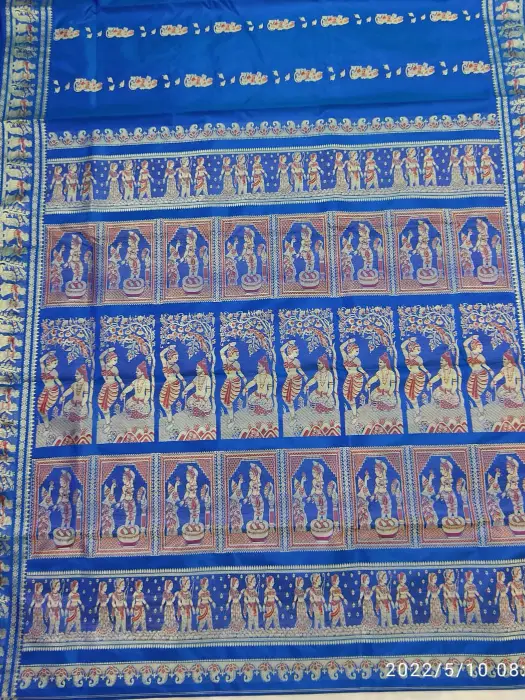A JOURNEY WITH BENGALI BALUCHARI AND SWARNACHARI SAREES - A GI TAGGED INDIAN HANDLOOM SILK SARI
 Minakari Baluchari
Minakari BaluchariWhat is history of Baluchari:
Baluchari, an Indian textile art, originated in Bengal during the 18th century. It gained prominence under the patronage of Murshidabad's Nawab. Crafted from fine silk using the supplementary weft technique, Baluchari sarees showcase elaborate motifs and narratives inspired by nature, mythology, and daily life. These intricately woven sarees embody cultural heritage, artistic finesse, and historical significance, making them a cherished part of India's textile legacy.R
 Traditional Baluchariecently Govt. of India has given Baluchari GI Tag in 2012.
Traditional Baluchariecently Govt. of India has given Baluchari GI Tag in 2012.What are different types of Baluchari saris you should collect?
There are several types of Baluchari saris based on their designs and motifs. Here are some of the common types:Classical Baluchari Sari:
This type of Baluchari sari features elaborate woven designs that often depict stories from the Indian epics like the Ramayana and Mahabharata. The borders and pallu (the loose end of the sari draped over the shoulder) are adorned with these intricate designs.Contemporary Baluchari Sari:
While traditional Baluchari saris focus on depicting mythological scenes, contemporary Baluchari saris may incorporate modern and abstract designs. These saris often appeal to younger generations who prefer a fusion of tradition and modernity.Swarnachari Sari:
Swarnachari saris are a variation of Baluchari saris that incorporate gold or silver zari threads along with silk threads. These saris 2k butic Swarnachari
2k butic SwarnachariRajbalah Sari:
Rajbalah saris are a specific type of Baluchari sari that originated in Murshidabad, West Bengal. They typically feature intricate floral and paisley patterns, and they're known for their fine quality and elegant appearance.Nakshi Kantha Baluchari Sari:
Nakshi Kantha is a type of embroidery that involves intricate stitching to create textured patterns. In Nakshi Kantha Baluchari saris, this embroidery technique is used to create detailed designs on the fabric.Contemporary Motif Baluchari Sari:
In addition to traditional and mythological motifs, contemporary Baluchari saris can incorporate a wide range of themes, including nature, animals, abstract art, and more. These designs cater to modern tastes while still retaining the essence of Baluchari weaving.Meenakari Baluchari Sari:
Meenakari refers to the art of adding enamel colors to metal surfaces. In Meenakari Baluchari saris, enamel-like colors are used to enhance the beauty of the woven designs. This technique adds a vibrant touch to the sari's appearance. Minakari Baluchari
Minakari BaluchariWhat are materials used to create Baluchari ?
Baluchari sarees are traditionally crafted using fine silk fabric. The base silk material is adorned with intricate motifs and designs using supplementary weft weaving technique. This technique involves using a contrast-colored silk thread to create the elaborate patterns, resulting in the characteristic Baluchari style known for its artistic appeal and historical significance.What are the life spans of Baluchari ?
The lifespan of a Baluchari saree largely depends on how well it is cared for and maintained. With proper care, a Baluchari saree made from high-quality silk can last for decades or at least 3 generations. However, factors like storage, handling, and exposure to sunlight or moisture can impact its longevity. Dry cleaning, proper storage in a cool and dry place, and avoiding direct sunlight can help preserve the saree's beauty and extend its lifespan.Check the Government of India Silk Mark:
Silk Mark is given by the Silk Mark Organisation of India (SMOI). These are fixed only on pure silk products by the authorised makers of Silk Mark. Each silkmark contains a hologram and a no/ bar code , which helps the buyer track the silk product back to the authentic maker.In the absence of Silk Mark, If something feels off or too good to be true, it's important to trust your instincts and consider looking for another option.
What are the current challenges for Baluchari sarees to sustain
Baluchari sarees encounter challenges like dwindling skilled artisans, competition from modern fabrics, and maintaining authenticity in a rapidly changing market. Preserving intricate weaving techniques and historical motifs while adapting to contemporary demands is a delicate balance for this traditional craft.But due to its uniqueness and heritage able to sustain even in current time and get love from Indian art lovers and collectors.




